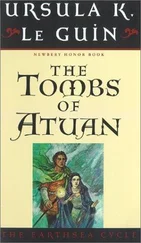Ursula Le Guin - The Shobies' Story
Здесь есть возможность читать онлайн «Ursula Le Guin - The Shobies' Story» весь текст электронной книги совершенно бесплатно (целиком полную версию без сокращений). В некоторых случаях можно слушать аудио, скачать через торрент в формате fb2 и присутствует краткое содержание. Жанр: Фантастика и фэнтези, на английском языке. Описание произведения, (предисловие) а так же отзывы посетителей доступны на портале библиотеки ЛибКат.
- Название:The Shobies' Story
- Автор:
- Жанр:
- Год:неизвестен
- ISBN:нет данных
- Рейтинг книги:4 / 5. Голосов: 1
-
Избранное:Добавить в избранное
- Отзывы:
-
Ваша оценка:
- 80
- 1
- 2
- 3
- 4
- 5
The Shobies' Story: краткое содержание, описание и аннотация
Предлагаем к чтению аннотацию, описание, краткое содержание или предисловие (зависит от того, что написал сам автор книги «The Shobies' Story»). Если вы не нашли необходимую информацию о книге — напишите в комментариях, мы постараемся отыскать её.
The Shobies' Story — читать онлайн бесплатно полную книгу (весь текст) целиком
Ниже представлен текст книги, разбитый по страницам. Система сохранения места последней прочитанной страницы, позволяет с удобством читать онлайн бесплатно книгу «The Shobies' Story», без необходимости каждый раз заново искать на чём Вы остановились. Поставьте закладку, и сможете в любой момент перейти на страницу, на которой закончили чтение.
Интервал:
Закладка:
The Shobies’ Story
Ursula K. Le Guin
They met at Ve Port more than a month before their first flight together, and there, calling themselves after their ship as most crews did, became the Shobies. Their first consensual decision was to spend their isyeye in the coastal village of Liden, on Hain, where the negative ions could do their thing.
Liden was a fishing port with an eighty-thousand-year history and a population of four hundred. Its fisherfolk farmed the rich shoal waters of their bay, shipped the catch inland to the cities, and managed the Liden Resort for vacationers and tourists and new space crews on isyeye (the word is Hainish and means “making a beginning together,” or “beginning to be together,” or, used technically, “the period of time and area of space in which a group forms if it is going to form.” A honeymoon is an isyeye of two). The fisherwomen and fishermen of Liden were as weathered as driftwood and about as talkative. Six-year-old Asten, who had misunderstood slightly, asked one of them if they were all eighty thousand years old. “Nope,” she said.
Like most crews, the Shobies used Hainish as their common language. So the name of the one Hainish crew member, Sweet Today, carried its meaning as words as well as name, and at first seemed a silly thing to call a big, tall, heavy woman in her late fifties, imposing of carriage and almost as taciturn as the villagers. But her reserve proved to be a deep well of congeniality and tact, to be called upon as needed, and her name soon began to sound quite right. She had family—all Hainish have family—kinfolk of all denominations, grandchildren and cross-cousins, affines and cosines, scattered all over the Ekumen, but no relatives in this crew. She asked to be Grandmother to Rig, Asten, and Betton, and was accepted.
The only Shoby older than Sweet Today was the Terran Lidi, who was seventy-two EYs and not interested in grandmothering. Lidi had been navigating for fifty years, and there was nothing she didn’t know about NAFAL ships, although occasionally she forgot that their ship was the Shoby and called it the Soso or the Alterra . And there were things she didn’t know, none of them knew, about the Shoby .
They talked, as human beings do, about what they didn’t know.
Churten theory was the main topic of conversation, evenings at the driftwood fire on the beach after dinner. The adults had read whatever there was to read about it, of course, before they ever volunteered for the test mission. Gveter had more recent information and presumably a better understanding of it than the others, but it had to be pried out of him. Only twenty-five, the only Cetian in the crew, much hairier than the others, and not gifted in language, he spent a lot of time on the defensive. Assuming that as an Anarresti he was more proficient at mutual aid and more adept at cooperation than the others, he lectured them about their propertarian habits; but he held tight to his knowledge, because he needed the advantage it gave him. For a while he would speak only in negatives: don’t call it the churten “drive,” it isn’t a drive, don’t call it the churten “effect,” it isn’t an effect. What is it, then? A long lecture ensued, beginning with the rebirth of Cetian physics since the revision of Shevekian temporalism by the Intervalists, and ending with the general conceptual framework of the churten. Everyone listened very carefully, and finally Sweet Today spoke, carefully. “So the ship will be moved,” she said, “by ideas?”
“No, no, no, no,” said Gveter. But he hesitated for the next word so long that Karth asked a question: “Well, you haven’t actually talked about any physical, material events or effects at all.” The question was characteristically indirect. Karth and Oreth, the Gethenians who with their two children were the affective focus of the crew, the “hearth” of it, in their terms, came from a not very theoretically minded subculture, and knew it. Gveter could run rings round them with his Cetian physico-philosophico-techno-natter. He did so at once. His accent did not make his explanations any clearer. He went on about coherence and meta-intervals, and at last demanded, with gestures of despair, “Khow can I say it in Khainish? No! It is not physical, it is not not physical, these are the categories our minds must discard entirely, this is the khole point!”
“Buth-buth-buth-buth-buth-buth,” went Asten, softly, passing behind the half circle of adults at the driftwood fire on the wide, twilit beach. Rig followed, also going, “Buth-buth-buth-buth,” but louder. They were being spaceships, to judge from their maneuvers around a dune and their communications—“Locked in orbit, Navigator!”—But the noise they were imitating was the noise of the little fishing boats of Liden putt-putting out to sea.
“I crashed!” Rig shouted, flailing in the sand. “Help! Help! I crashed!”
“Hold on, Ship Two!” Asten cried. “I’ll rescue you! Don’t breathe! Oh, oh, trouble with the Churten Drive! Buth-buth-ack! Ack! Brrrrmmm-ack-ack-ack-rrrrrmmmmm, buth-buth-buth-buth…”
They were six and four EYs old. Tai’s son Betton, who was eleven, sat at the driftwood fire with the adults, though at the moment he was watching Rig and Asten as if he wouldn’t mind taking off to help rescue Ship Two. The little Gethenians had spent more time on ships than on planet, and Asten liked to boast about being “actually fifty-eight,” but this was Betton’s first crew, and his only NAFAL flight had been from Terra to Hain. He and his biomother, Tai, had lived in a reclamation commune on Terra. When she had drawn the lot for Ekumenical service, and requested training for ship duty, he had asked her to bring him as family. She had agreed; but after training, when she volunteered for this test flight, she had tried to get Betton to withdraw, to stay in training or go home. He had refused. Shan, who had trained with them, told the others this, because the tension between the mother and son had to be understood to be used effectively in group formation. Betton had requested to come, and Tai had given in, but plainly not with an undivided will. Her relationship to the boy was cool and mannered. Shan offered him fatherly-brotherly warmth, but Betton accepted it sparingly, coolly, and sought no formal crew relation with him or anyone.
Ship Two was being rescued, and attention returned to the discussion. “All right,” said Lidi. “We know that anything that goes faster than light, any thing that goes faster than light, by so doing transcends the material/immaterial category—that’s how we got the ansible, by distinguishing the message from the medium. But if we, the crew, are going to travel as messages, I want to understand how .”
Gveter tore his hair. There was plenty to tear. It grew fine and thick, a mane on his head, a pelt on his limbs and body, a silvery nimbus on his hands and face. The fuzz on his feet was, at the moment, full of sand. “Khow!” he cried. “I’m trying to tell you khow! Message, information, no no no, that’s old, that’s ansible technology. This is transilience! Because the field is to be conceived as the virtual field, in which the unreal interval becomes virtually effective through the mediary coherence—don’t you see?”
“No,” Lidi said. “What do you mean by mediary?”
After several more bonfires on the beach, the consensus opinion was that churten theory was accessible only to minds very highly trained in Cetian temporal physics. There was a less freely voiced conviction that the engineers who had built the Shoby ’s churten apparatus did not entirely understand how it worked. Or, more precisely, what it did when it worked. That it worked was certain. The Shoby was the fourth ship it had been tested with, using robot crew; so far sixty-two instantaneous trips, or transiliences, had been effected between points from four hundred kilometers to twenty-seven lightyears apart, with stopovers of varying lengths. Gveter and Lidi steadfastly maintained that this proved that the engineers knew perfectly well what they were doing, and that for the rest of them the seeming difficulty of the theory was only the difficulty human minds had in grasping a genuinely new concept.
Читать дальшеИнтервал:
Закладка:
Похожие книги на «The Shobies' Story»
Представляем Вашему вниманию похожие книги на «The Shobies' Story» списком для выбора. Мы отобрали схожую по названию и смыслу литературу в надежде предоставить читателям больше вариантов отыскать новые, интересные, ещё непрочитанные произведения.
Обсуждение, отзывы о книге «The Shobies' Story» и просто собственные мнения читателей. Оставьте ваши комментарии, напишите, что Вы думаете о произведении, его смысле или главных героях. Укажите что конкретно понравилось, а что нет, и почему Вы так считаете.



